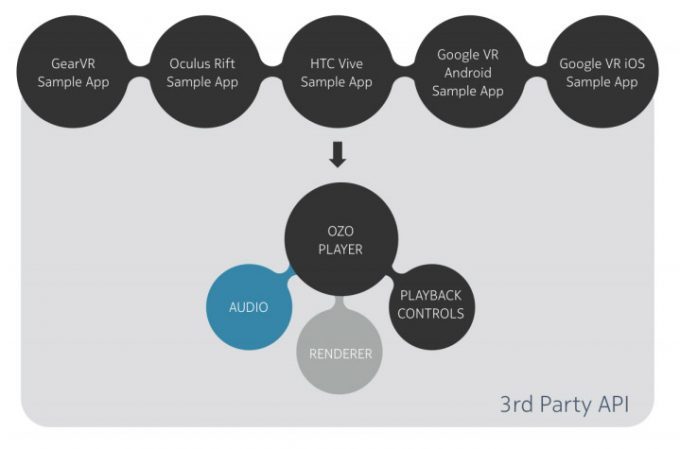Nokia has launched the OZO Player SDK, a cross-platform foundation for creating applications with high fidelity VR video playback. Road to VR spoke with Nokia’s Head of VR Technologies, Tarif Sayed to learn more about the offering.
While VR video portals like Jaunt, Littlstar, Samsung VR, and others offer a single destination from which to stream many different 360 and VR videos, another popular way to distribute VR video has been as a standalone app, offering more complete control over the experience by the creator. For instance, Felix & Paul’s Nomads is a single app which lets viewers watch a 3-part VR video series, and also provides a proprietary interface and supporting non-video content. Other VR apps focus on real-time rendered experiences, but occasionally weave VR video content throughout when advantageous.
Creating such a VR video apps requires a playback engine that knows how to handle the particular type of VR video and audio as provided by the creator. That could range from a 360 mono video, 360 3D, or even 180 3D. Each of those could be using a separate framerate and surround audio format, which means a VR video app needs a playback engine which can handle whichever specific combination of characteristics the content calls for.
Nokia is aiming to simplify the process of building VR apps which incorporate VR video with the newly released OZO Player SDK, a cross-platform playback engine that’s designed to jumpstart VR video app development by handling the major functions involved in playing back a VR video file in high fidelity.

Despite being part of the OZO brand, the SDK works with any VR video content, not just that filmed with Nokia’s OZO VR camera. The cross-platform nature of the OZO Player SDK will be especially useful for those who want to widely distribute VR apps with VR video across multiple platforms, says Nokia’s Head of VR Technologies, Sarif Sayed.
“When it comes to VR video playback, there’s at least 20 different SDKs [you could find when you search], there’s no universal option. We decided to really go and have a product that solves most of the key issues with VR playback. We introduced [the OZO Player SDK] available for Oculus Rift, HTC Vive, Gear VR, Google Daydream, and Cardboard (iOS and Android),” Sayed told Road to VR.
The OZO Player SDK comes as both a native SDK and a Unity plugin for those already building VR apps with Unity. PlayStation VR isn’t yet supported, but Nokia likely has it in the works for future releases.
“There’s a lot of things coming in the pipeline to enhance the SDK. But any user who wants to deliver their VR experience now, they can use it to publish on all the major platforms.”
In addition to being widely cross-platform, the OZO Player SDK supports all major video file delivery methods, meaning it can be used to play a local VR video file, stream a cloud-hosted file, or even a live feed, Sayed says, including support for variable bitrate streaming which can automatically adapt quality based on available bandwidth.
According to Sayed, a major advantage of the SDK is support for three major projection formats: Equirectangular, Cubemap, and Lambert, as well as various video formats and framerates; the playback engine can handle 360 video that’s stereoscopic or monoscopic, and 180 stereoscopic video, all up to 60FPS and 4K resolution per-eye. As devices get more powerful, Sayed says the OZO Player SDK will be able to handle 6K and 8K resolutions.
When it comes to audio, the SDK uses an HRTF-based rendering with support for stereo audio, 5.0, 4.0, 7.0 surround formats, and the proprietary OZO Audio 360 format that’s captured with the OZO camera’s eight on-board microphones.

To jumpstart development, Nokia is also making available reference applications on each platform supported by the SDK, so that developers can use them as a jumping-off point for developing apps incorporating VR video content.
Sayed says a free version of the OZO Player SDK is now available, which is fully functional except for a watermark. If companies want to use it to launch an app, Nokia is offering case-by-case licensing options, which includes future updates and support.
“The pricing question took us so long… we couldn’t follow the industry way of charging a yearly fee or per user… part of our mission is to support the industry to grow. We said ‘we’re not going to implement a pricing model that we’ll apply to everyone in the world’ because at this point not everyone knows how to monetize VR. So we work one-on-one to offer flexible pricing models that suit every client,” Sayed said. “Our sales and legal team hate me [because of the work this causes them],” he joked.
It’s yet to be seen how VR video content will be primarily consumed; while the video portal model dominates the traditional video space, the unique needs of VR could be more suited to a dedicated app model, and we see no shortage of such apps presently in the young VR marketplace. The question is likely to be answered once monetization methods of VR video content become more clear.







